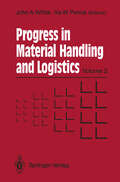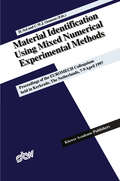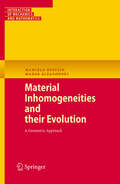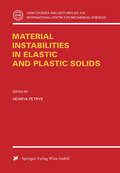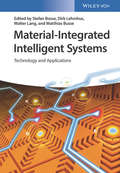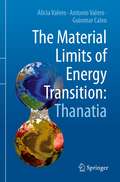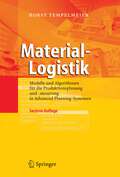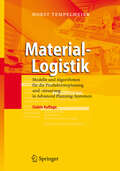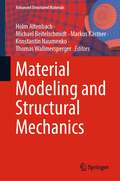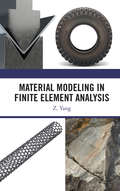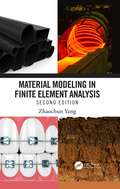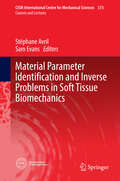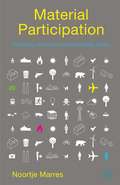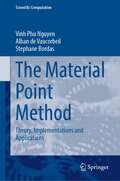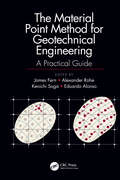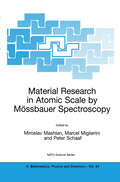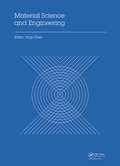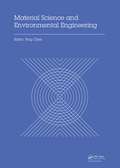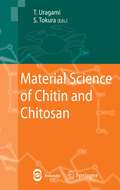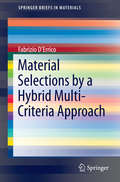- Table View
- List View
Material Handling ’90 (Progress in Materials Handling and Logistics #2)
by Robert J. Graves Leon F. McGinnis Mickey R. Wilhelm Richard E. WardThe contents of this book are based on invited papers submittedfor presentation and discussion at the 1990 Material Handling Research Colloquium held in Hebron, Kentucky, June 19-21,1990. The Colloquium was sponsored and organized by the College Industry Councilfor Material Handling Education (CIC-MHE) with addi tional co-sponsorship and funding provided by numerous organizations (see ac knowledgements). The purpose of the Colloquium was to foster open discussion about the current state of material handling research at universitiesfrom across the United States and Canada. It was an opportunity to share specific research directions and accomplishments. But more importantly, it was an opportunity to discuss the implications of the basic constraints to solving industry relevant problems in the field of material handling and closely related activities; the efficacy of the approaches being taken at the present time; and the directions believed to be of most value to the industry and to advancing the knowledge and science base of the material handling engineering discipline. The sponsoring organization, the College Industry Council for Material Handling Education was founded in 1952. The council is composed of college and university educators, material handling equipment manufacturers, distributors, users and consultants, representatives of the business press plus professional staff and members of other organizations concerned with material handling education.
Material Identification Using Mixed Numerical Experimental Methods: Proceedings of the EUROMECH Colloquium held in Kerkrade, The Netherlands, 7–9 April 1997
by Hugo Sol Cees W. J. OomensEuromech 357 took place in the nice authentic monastery 'Rolduc' in Kerkrade, Holland. The objective was to bring together researchers to present their latest advancements in the relatively new domain of Material properties identification by Mixed Numerical Experimental Methods (MMM). MMM are a modem and increasingly powerful way to determine the values of unknown parameters in a numerical model by observations made on real physical test structures. Starting from the measurement of output values (like displacements, stresses, velocities, vibrations, .. ) of the real physical test structure, MMM try to update parameters in the numerical model in such a way that the computed observations match the experimental observations. It was shown clearly at the colloquium that the combined use of numerical analysing tools and sophisticated measurement techniques has created an extra degree of freedom for the design of experiments and has led to new approaches for material characterisation. The colloquium was attended by 39 participants coming from 12 different European countries. We had 23 oral presentations on the different topics of the above mentioned sessions. Each presentation was followed by an intensive discussion. Du~ to the informal atmosphere and the limited number of participants, the discussions were very lively and fruitful. The opportunity to continue to discuss common problems after dinner in a reserved place was also offered to the Euromech participants. This opportunity and the fact that the monastery was isolated (nobody could escape!) created an excellent platform for discussions and personal contacts.
Material Inhomogeneities and their Evolution: A Geometric Approach (Interaction of Mechanics and Mathematics)
by Marcelo Epstein Marek ElzanowskiWith its origins in the theories of continuous distributions of dislocations and ofmetalplasticity,inhomogeneitytheoryisarichandvibrant?eldofresearch. The recognition of the important role played by con?gurational or material forces in phenomena such as growth and remodelling is perhaps its greatest present-day impetus. While some excellent comprehensive works approa- ing the subject from di?erent angles have been published, the objective of this monograph is to present a point of view that emphasizes the di?erenti- geometric aspects of inhomogeneity theory. In so doing, we follow the general lines of thought that we have propounded in many publications and presen- tions over the last two decades. Although based on these sources, this book is a stand-alone entity and contains some new results and perspectives. At the same time, it does not intend to present either a historical account of the - velopment of the subject or a comprehensive picture of the various schools of thought that can be encountered by perusing scholarly journals and attending specialized symposia. The book is divided into three parts, the ?rst of which is entirely devoted to the formulation of the theory in the absence of evolution. In other words, time is conspicuously absent from Part I. It opens with the geometric ch- acterization of material inhomogeneity within the context of simple bodies in Chapter 1, followed by extensions to second-grade and Cosserat media in Chapters 2 and 3.
Material Instabilities in Elastic and Plastic Solids (CISM International Centre for Mechanical Sciences #414)
by Henryk PetrykThis book collects recent theoretical developments in the area of material instability in elastic and plastic solids along with related analytical and numerical methods and applications. The existing different approaches to instability phenomena in metal single crystals, polycristals and in geomaterials are presented with the emphasis laid on mutual relations and on unifying concepts, including elliptictly loss and the energy criterion. Quasi-static bifurcation, initiation of single or multiple shear bands and post-critical strain localization are examined along with dynamic phenomena as wave propagation, moving shocks, internal snap-through and instability of flutter type. This gives an overview of a variety of material instability problems, methods and applications.
Material-Integrated Intelligent Systems: Technology and Applications
by Stefan Bosse Dirk Lehmhus Walter Lang Matthias BusseCombining different perspectives from materials science, engineering, and computer science, this reference provides a unified view of the various aspects necessary for the successful realization of intelligent systems. The editors and authors are from academia and research institutions with close ties to industry, and are thus able to offer first-hand information here. They adopt a unique, three-tiered approach such that readers can gain basic, intermediate, and advanced topical knowledge. The technology section of the book is divided into chapters covering the basics of sensor integration in materials, the challenges associated with this approach, data processing, evaluation, and validation, as well as methods for achieving an autonomous energy supply. The applications part then goes on to showcase typical scenarios where material-integrated intelligent systems are already in use, such as for structural health monitoring and smart textiles.
Material-Integrated Intelligent Systems: Technology and Applications
by Stefan Bosse Dirk Lehmhus Walter Lang Matthias BusseCombining different perspectives from materials science, engineering, and computer science, this reference provides a unified view of the various aspects necessary for the successful realization of intelligent systems. The editors and authors are from academia and research institutions with close ties to industry, and are thus able to offer first-hand information here. They adopt a unique, three-tiered approach such that readers can gain basic, intermediate, and advanced topical knowledge. The technology section of the book is divided into chapters covering the basics of sensor integration in materials, the challenges associated with this approach, data processing, evaluation, and validation, as well as methods for achieving an autonomous energy supply. The applications part then goes on to showcase typical scenarios where material-integrated intelligent systems are already in use, such as for structural health monitoring and smart textiles.
The Material Limits of Energy Transition: Thanatia
by Alicia Valero Antonio Valero Guiomar CalvoEarth has become a huge mine, with a greater quantity and variety of fundamental mineral resources being extracted year after year. Technology, from electric cars to everyday electrical equipment, consume vast amounts of scarce raw materials. On a planet with limited resources, are these minerals being properly assessed? Will there be enough raw materials to meet the demand of a world population on track to reach 10 billion people? What will be the consequences of accelerated resource depredation? Will the planet one day become 'Thanatia', a resource-exhausted Earth?This book allows readers to understand the mineral heritage of the Earth, considering the demand for raw materials in society, comparing it with the availability of resources on Earth and the impact of mining. The basics of physical geonomics are exlpained, allowing readers to analyse the loss of mineral resources on the planet. The impact of renewable energies and technologies, including electric vehicles, are studied. The book concludes with possible solutions to mineral depletion, from increasing recycling rates, ecodesign measures or alternative sources of mineral resources. Providing numerous tables and illustrations, 'The Material Limits of Energy Transition: Thanatia' gives readers a thorough understanding of mineral depletion. Exploring geology, geochemistry, mining, metallurgy, the environment and thermodynamics, this is a truly holistic book.
Material-Logistik: Modelle und Algorithmen für die Produktionsplanung und -steuerung in Advanced Planning-Systemen
by Horst TempelmeierDas Buch vermittelt einen umfassenden Überblick über Modelle und Algorithmen zur dynamischen Losgrößenoptimierung für ein- und mehrstufige Erzeugnisstrukturen, die eingehend erläutert und anhand zahlreicher Beispiele veranschaulicht werden. Außerdem werden Verfahren zur optimalen Bestellmengenplanung und Lieferantenauswahl unter Beachtung von Mengenrabatten dargestellt. Weiterhin werden die Prognoseverfahren, die in zahlreichen Advanced Planning-Systemen implementiert sind, detailliert erläutert. Schließlich wird gezeigt, wie die dargestellten Prognose- und Planungskonzepte in den SAP-Systemen mySAP SCM (APO) und R/3 umgesetzt werden.
Material-Logistik: Modelle und Algorithmen für die Produktionsplanung und -steuerung in Advanced Planning-Systemen
by Horst TempelmeierDas Buch vermittelt einen umfassenden Überblick über Modelle und Algorithmen zur dynamischen Losgrößenoptimierung für ein- und mehrstufige Erzeugnisstrukturen, die eingehend erläutert und anhand zahlreicher Beispiele veranschaulicht werden. Außerdem werden Verfahren zur optimalen Bestellmengenplanung und Lieferantenauswahl unter Beachtung von Mengenrabatten dargestellt. Weiterhin werden die Prognoseverfahren, die in zahlreichen Advanced Planning-Systemen implementiert sind, detailliert erläutert. Schließlich wird gezeigt, wie die dargestellten Prognose- und Planungskonzepte in den SAP-Systemen mySAP SCM (APO) und R/3 umgesetzt werden. Gegenüber der sechsten Auflage wurden erhebliche Veränderungen vorgenommen. So wird nun unterschieden zwischen Mikroperiodenmodellen und Makroperiodenmodellen zur dynamischen Losgrößenplanung mit der Folge, dass der Abschnitt zur Losgrößenplanung entsprechend umgestellt und beträchtlich ausgeweitet werden musste. Das Buch richtet sich an Studierende der Betriebswirtschaftslehre sowie des Wirtschaftsingenieurwesens und der Wirtschaftsinformatik, aber auch an interessierte Praktiker, die in ihrem beruflichen Umfeld mit Produktionsplanung und -steuerung, Advanced Planning-Systemen oder Logistik bzw. Supply Chain Management zu tun haben.
Material Modeling and Structural Mechanics (Advanced Structured Materials #161)
This book presents various questions of continuum mechanical modeling in the context of experimental and numerical methods, in particular, multi-field problems that go beyond the standard models of continuum mechanics. In addition, it discusses dynamic problems and practical solutions in the field of numerical methods. It focuses on continuum mechanics, which is often overlooked in the traditional division of mechanics into statics, strength of materials and kinetics. The book is dedicated to Prof. Volker Ulbricht, who passed away on April 9, 2021.
Material Modeling in Finite Element Analysis
by Z. YangFinite element analysis has been widely applied in mechanical, civil, and biomedical designs. This book aims to provide the readers comprehensive views of various material models with practical examples, which would help readers understand various materials, and build appropriate material models in the finite element analysis. This book is composed of four main parts: 1) metals, 2) polymers, 3) soils, and 4) modern materials. Each part starts with the structure and function of different materials and then follows the corresponding material models such as BISO, MISO, Chaboche model in metals, Arruda-Boyce model, Mooney-Rivlin model, Ogden model in polymers, Mohr-Coulomb model, Cam Clay model and Jointed Rock model in geomechanics, composites and shape memory alloys in modern materials. The final section presents some specific problems, such as metal forming process, combustion chamber, Mullins effect of rubber tire, breast shape after breast surgery, viscoelasticity of liver soft tissues, tunnel excavation, slope stability, orthodontic wire, and piezoelectric microaccelerometer. All modeling files are provided in the appendixes of the book. This book would be helpful for graduate students and researchers in the mechanical, civil, and biomedical fields who conduct finite element analysis. The book provides all readers with comprehensive understanding of modeling various materials.
Material Modeling in Finite Element Analysis
by Z. YangFinite element analysis has been widely applied in mechanical, civil, and biomedical designs. This book aims to provide the readers comprehensive views of various material models with practical examples, which would help readers understand various materials, and build appropriate material models in the finite element analysis. This book is composed of four main parts: 1) metals, 2) polymers, 3) soils, and 4) modern materials. Each part starts with the structure and function of different materials and then follows the corresponding material models such as BISO, MISO, Chaboche model in metals, Arruda-Boyce model, Mooney-Rivlin model, Ogden model in polymers, Mohr-Coulomb model, Cam Clay model and Jointed Rock model in geomechanics, composites and shape memory alloys in modern materials. The final section presents some specific problems, such as metal forming process, combustion chamber, Mullins effect of rubber tire, breast shape after breast surgery, viscoelasticity of liver soft tissues, tunnel excavation, slope stability, orthodontic wire, and piezoelectric microaccelerometer. All modeling files are provided in the appendixes of the book. This book would be helpful for graduate students and researchers in the mechanical, civil, and biomedical fields who conduct finite element analysis. The book provides all readers with comprehensive understanding of modeling various materials.
Material Modeling in Finite Element Analysis
by Zhaochun YangFinite element analysis has been widely applied in mechanical, civil, and biomedical designs. This new edition provides the readers with comprehensive views of various material models through practical examples, which will help them better understand various materials and build appropriate material models in finite element analysis. Material Modeling in Finite Element Analysis, Second Edition, consists of four main parts: (1) metals, (2) polymers, (3) soils, and (4) modern materials. Each part starts with the structure and function of different materials and then follows the corresponding material models and the temperature and time effects on the material models. The final part focuses on user subroutines such as UserMat and UserHyper. This book presents some specific problems including the metal-forming process, combustion room, Mullins effect of rubber tires, viscoelasticity of liver soft tissues, small punch test, tunnel excavation, slope stability, concrete slump test, orthodontic wire, and piezoelectric microaccelerometer. All modeling files are provided in the appendices of this book. This book would be helpful for graduate students and researchers in the mechanical, civil, and biomedical fields who conduct finite element analysis. This book provides all readers with a comprehensive understanding of modeling various materials.
Material Modeling in Finite Element Analysis
by Zhaochun YangFinite element analysis has been widely applied in mechanical, civil, and biomedical designs. This new edition provides the readers with comprehensive views of various material models through practical examples, which will help them better understand various materials and build appropriate material models in finite element analysis. Material Modeling in Finite Element Analysis, Second Edition, consists of four main parts: (1) metals, (2) polymers, (3) soils, and (4) modern materials. Each part starts with the structure and function of different materials and then follows the corresponding material models and the temperature and time effects on the material models. The final part focuses on user subroutines such as UserMat and UserHyper. This book presents some specific problems including the metal-forming process, combustion room, Mullins effect of rubber tires, viscoelasticity of liver soft tissues, small punch test, tunnel excavation, slope stability, concrete slump test, orthodontic wire, and piezoelectric microaccelerometer. All modeling files are provided in the appendices of this book. This book would be helpful for graduate students and researchers in the mechanical, civil, and biomedical fields who conduct finite element analysis. This book provides all readers with a comprehensive understanding of modeling various materials.
Material Parameter Identification and Inverse Problems in Soft Tissue Biomechanics (CISM International Centre for Mechanical Sciences #573)
by Stéphane Avril Sam EvansThe articles in this book review hybrid experimental-computational methods applied to soft tissues which have been developed by worldwide specialists in the field. People developing computational models of soft tissues and organs will find solutions for calibrating the material parameters of their models; people performing tests on soft tissues will learn what to extract from the data and how to use these data for their models and people worried about the complexity of the biomechanical behavior of soft tissues will find relevant approaches to address this complexity.
Material Participation: Technology, the Environment and Everyday Publics
by N. MarresThis book develops a fresh perspective on everyday forms of engagement, one that foregrounds the role of objects, technologies and settings in democracy. Examining a range of devices, from smart meters to eco-homes, the book sets out new concepts and methods for analyzing the relations between participation, innovation and the environment.
The Material Point Method: Theory, Implementations and Applications (Scientific Computation)
by Vinh Phu Nguyen Alban de Vaucorbeil Stephane BordasThis book provides an introduction to the fundamental theory, practical implementation, and core and emerging applications of the material point method (MPM) and its variants. The MPM combines the advantages of both finite element analysis (FEM) and meshless/meshfree methods (MMs) by representing the material by a set of particles overlaid on a background mesh that serves as a computational scratchpad.The book shows how MPM allows a robust, accurate, and efficient simulation of a wide variety of material behaviors without requiring overly complex implementations. MPM and its variants have been shown to be successful in simulating a large number of high deformation and complicated engineering problems such as densification of foam, sea ice dynamics, landslides, and energetic device explosions, to name a few, and have recently found applications in the movie industry. It is hoped that this comprehensive exposition on MPM variants and their applications will not only provide an opportunity to re-examine previous contributions, but also to re-organize them in a coherent fashion and in anticipation of new advances.Sample algorithms for the solutions of benchmark problems are provided online so that researchers and graduate students can modify these algorithms and develop their own solution algorithms for specific problems. The goal of this book is to provide students and researchers with a theoretical and practical knowledge of the material point method to analyze engineering problems, and it may help initiate and promote further in-depth studies on the subjects discussed.
The Material Point Method for Geotechnical Engineering: A Practical Guide
by James Fern Alexander Rohe Kenichi Soga Eduardo AlonsoThis practical guide provides the best introduction to large deformation material point method (MPM) simulations for geotechnical engineering. It provides the basic theory, discusses the different numerical features used in large deformation simulations, and presents a number of applications -- providing references, examples and guidance when using MPM for practical applications. MPM covers problems in static and dynamic situations within a common framework. It also opens new frontiers in geotechnical modelling and numerical analysis. It represents a powerful tool for exploring large deformation behaviours of soils, structures and fluids, and their interactions, such as internal and external erosion, and post-liquefaction analysis; for instance the post-failure liquid-like behaviours of landslides, penetration problems such as CPT and pile installation, and scouring problems related to underwater pipelines. In the recent years, MPM has developed enough for its practical use in industry, apart from the increasing interest in the academic world.
The Material Point Method for Geotechnical Engineering: A Practical Guide
by James Fern Alexander Rohe Kenichi Soga Eduardo AlonsoThis practical guide provides the best introduction to large deformation material point method (MPM) simulations for geotechnical engineering. It provides the basic theory, discusses the different numerical features used in large deformation simulations, and presents a number of applications -- providing references, examples and guidance when using MPM for practical applications. MPM covers problems in static and dynamic situations within a common framework. It also opens new frontiers in geotechnical modelling and numerical analysis. It represents a powerful tool for exploring large deformation behaviours of soils, structures and fluids, and their interactions, such as internal and external erosion, and post-liquefaction analysis; for instance the post-failure liquid-like behaviours of landslides, penetration problems such as CPT and pile installation, and scouring problems related to underwater pipelines. In the recent years, MPM has developed enough for its practical use in industry, apart from the increasing interest in the academic world.
Material Properties under Intensive Dynamic Loading (Shock Wave and High Pressure Phenomena)
by William W. Anderson Frank J. Cherne Marvin A. ZocherUnderstanding the physical and thermomechanical response of materials subjected to intensive dynamic loading is a challenge of great significance in engineering today. This volume assumes the task of gathering both experimental and diagnostic methods in one place, since not much information has been previously disseminated in the scientific literature.
Material Research in Atomic Scale by Mössbauer Spectroscopy (NATO Science Series II: Mathematics, Physics and Chemistry #94)
by Miroslav Mashlan Marcel Miglierini Peter SchaafMössbauer spectroscopy is uniquely able to probe hyperfine interactions by looking at the short-range order of resonant atoms. Materials containing an appropriate isotope as one of their constituent atoms, such as iron or tin, are readily investigated. But even materials that do not contain Mössbauer-active atoms can be investigated if the probe atoms are incorporated in minor quantities (ca. 0.1 at.-%) to act as molecular-level indicators. These 35 papers collected here represent a state-of-the-art description of Mössbauer spectroscopy techniques applied to advanced materials. The topics covered comprise investigations of nanomaterials, nanoparticles, and quasicrystals, artificially structured materials as well as applications of Mössbauer spectroscopy in chemistry, mineralogy and metallurgy. The main aim of is the dissemination of information on research and recent developments of the method in materials science as obtained in leading Mössbauer laboratories.
Material Science and Engineering: Proceedings of the 3rd Annual 2015 International Conference on Material Science and Engineering (ICMSE2015, Guangzhou, Guangdong, China, 15-17 May 2015)
by Ping ChenMaterial Science and Engineering presents novel and fundamental advances in the field of material science and engineering. This proceedings collects the comprehensive and worldwide research results on Metallic Materials and Applications, Chemical Materials, Electronic Materials, Nanomaterials, Composite and Polymer Materials, Bio and Medical Materi
Material Science and Environmental Engineering: Proceedings of the 3rd Annual 2015 International Conference on Material Science and Environmental Engineering (ICMSEE2015, Wuhan, Hubei, China, 5-6 June 2015)
by Ping ChenMaterial Science and Environmental Engineering presents novel and fundamental advances in the fields of material science and environmental engineering. Collecting the comprehensive and state-of-art in these fields, the contributions provide a broad overview of the latest research results, so that it will proof to be a valuable reference book to aca
Material Science of Chitin and Chitosan
by Tadashi Uragami Seichi TokuraChitin and chitosan are one of the most important key materials in the 21st century. They have multifunctional properties with applications in the pharmaceutical sciences, environmental problem-solving area (such as water-cleaning) to fibres, films and hydrogels, in cosmetics industry, food additives and as agricultural materials. The most active authors in the field summarize the basics and applications of chitin and chitosan keeping in mind their importance in the science and technology in the 21st century.
Material Selections by a Hybrid Multi-Criteria Approach (SpringerBriefs in Materials)
by Fabrizio D’ErricoThis Brief presents a new method that is based on the author and his students’ shared experience in applying a structured procedure that has as its main goal the creation of a material selection technique that uses language and employs a platform that is not restricted to engineers. Based on a hybrid approach that exploits both traditional and semi-quantitative concepts, it moves forward step-by step, and uses a platform based on a Quality Function Deployment matrix framework. Candidate materials are screened out and finally assessed by two user-friendly graphic analysis tools, one based on the value curve of the product and the other on an original Bubble Maps tool. The Brief is written for all those whose aim is for a better understanding of how to integrate and speed up the entire product development process from the initial product concept and engineering design phases to design specs, manufacturability and product marketing with optimal choice of materials.
